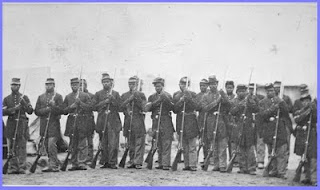Image Used as Recruitment Flyer for Black Union Soldiers
Recently, I came across a document of a soldier who enlisted in the 11th US, Colored Infantry which was organized in Ft. Smith Arkansas. Unlike many other soldiers of African Ancestry, this man enlisted in Illinois and was then sent directly to Arkansas for service with the 11th US Colored Infantry.
Source: Footnote.com Image: #33|113385616
He was recruited late in the Civil War and was expected to serve only for 1 year instead of the 3 year enlistment of others serving with the US Colored Troops.
Close Up of Muster Roll image from Service Record of James Aiken, 11th US Colored Infantry
Source: Footnote.com Image: #33|113385620
Apparently this soldier was part of a detachment of US Volunteers that were recruited out of the south, but they were destined for units serving in the south.
Portion of Image from Service Record of James Aiken, 11th US Colored Infantry
with Source: Footnote.com Image: #33|113385616
I thought the procedure was interesting, and was mostly likely something unique, but then, I had a conversation with another fellow researcher. She shared with me about her surprise to see a soldier from Canada who served in the 1st US Colored Cavalry that she was researching. This is a regiment organized in Virginia. The soldier she mentioned, Moses Smith, was born in Canada, and enlisted in the Union Army in Buffalo New Year. Like the soldier, whose name appears above, her soldier also enlisted in a regiment organized in the south, but he enlisted in Buffalo, NY.
Document Reflects the Enlistment of a Canadian Born Man Who Enlisted in Buffalo NY
Source: Footnote Image: #33|261413536
In this case Moses Smith entered the war in 1864 in Buffalo NY and was sent to be a part of the 1st US Colored Cavalry, which was organized at Camp Hamilton VA.
Another document reflecting detachment of US Volunteer Recruits
Source: Footnote Image #33|261413537
Trying to understand this I became more interested in the recruitment efforts for black soldiers. How did the word get to places far and near Union lines for able bodied men to join?
I learned that once approval was given to form the US Colored Troops, it was not uncommon to find flyers especially in northern cities, encouraging men of African descent to join the Union Army. I have found so far, 9 different recruitment flyers.
Some of the flyers were regiment specific:
Others directed men to a specific place to be trained:
Some flyers were very broad, simply appealing to men of color to join the fight for the Union:
The words were clear----soldiers were needed in the south and west.
I have found nine different images directed at enlisting black soldiers and found them all enlightening, and eye opening. The Civil War was truly complex, and the efforts to find men to fight was a mighty one as well.
Thankfully some of those stories can still be told by the artifacts that remain behind.































